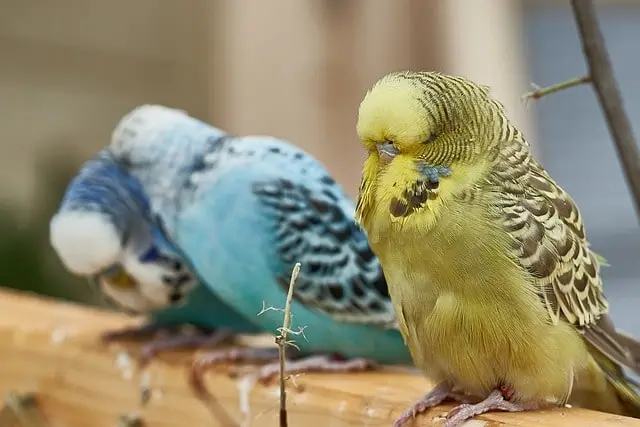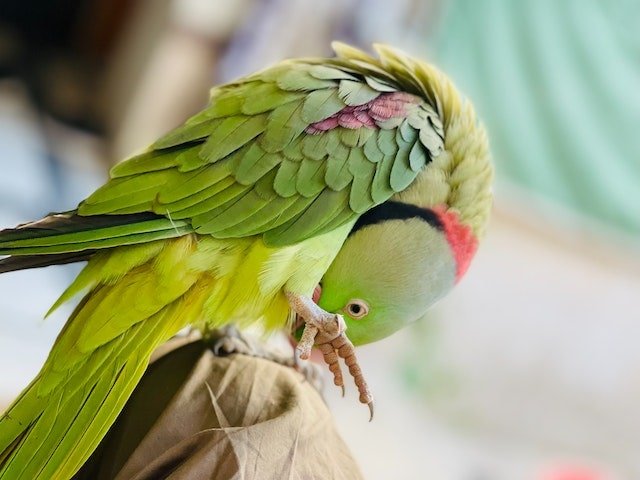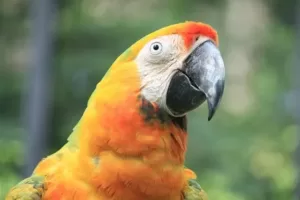Winter is probably the least fun season for parrots. Since most parrots originate in tropical regions they are used to living in warm and humid weather conditions year-round and aren’t naturally equipped to tolerate cold very well.
Certain species of parrots that come from temperate regions like Australia may be able to handle low indoor temperatures slightly better but in general, parrots need warm climates to stay comfortable.
In the wild, parrots usually experience temperatures between 40°F to 110°F, but they know where to escape when the weather gets extreme. However, for captive parrots, things are a bit different. They cannot acclimate to sudden changes in weather and need more temperature control in their living environment.
Quick Navigation
How Cold Can Parrots Tolerate?
While there are variations to how much cold a parrot can tolerate depending on the species, it is safe to say that parrots don’t do well in cold temperatures.
Baby parrots, older parrots, and ones with health conditions are particularly less tolerant of cold weather. They should be protected from cold and provided with a warm and comfortable enclosure.
That being said, any temperature under 4 degrees Celsius is too cold even for healthy parrots. If the temperature falls below freezing point, it becomes necessary to take active measures to ensure your parrot stays warm.
Exposure to such low temperatures for long periods can pose the risk of hypothermia and even death.
If they are exposed to low temperatures for a considerable length of time, hypothermia can set in, and possibly lead to fatal consequences. While it may not happen immediately, your parrot may show certain warning signs.
- At 39°F (4°C) and below, most parrots will start to shake and shiver.
- At 32°F (0°C) and below, parrots can get hypothermia and may even go into shock.
What Is The Ideal Temperature For Parrots?
The ideal temperatures may vary between species, but anything in the range of 65°F – 72°F (18°C – 22°C) is suitable for most parrots.
| Parrot Species | Ideal Household Temperatures |
| Cockatoos | 70-80°F (21-27°C) |
| African Greys | 70-80°F (21-27°C) |
| Macaws | 70-80°F (21-27°C) |
| Cockatiels | 70-80°F (21-27°C) |
| Budgerigars | 70-80°F (21-27°C) |
How Do I Know If My Parrot Is Cold?
If your parrot is shivering, it is probably very cold inside and you should increase the temperatures. When your parrot is starting to feel cold, it may show the following symptoms:

Fluffed-Up Feathers
Parrots can’t put on more layers to keep warm like us. However, they do have their own ways to provide themselves with warmth.
They have methods of regulating body temperatures to adapt to the changing weather conditions around them to some extent.
Because birds don’t have sweat glands, they rely on adjusting their feathers to prevent heat from escaping.
When a parrot feels cold, it will fluff up its feathers to trap the air inside them creating a layer of insulation.
This helps them warm up the air inside the feathers and increase their body temperature.
Tucking Its Beak In Feathers
Along with puffed-up feathers, you may also see your parrot turning its head backward and burying its beak in the feathers.
This allows them to conserve more body heat and regulate temperatures around their heads. It is also a common sleeping position for parrots that they get into particularly when feeling a little chilly.
Squatting
As the parrot’s feet are the only unfeathered area on its body, they can quickly lose body heat when they are exposed. Squatting allows parrots to tuck both of their feet inside their feathers which helps them retain heat.
Being Less Active Than Usual
When a parrot is feeling too cold, it may not be as active and usually sit in a corner in its cage or an area that is warm. Sometimes it may also go to the cage floor to seek warmth.
However, lethargy and reduced vocalizations could also mean that your parrot is sick. So you need to closely observe their behavior to make sure they are just feeling a little cold.
Can Parrots Be Kept Outside In The Cold?
Keeping your parrot outside in the cold may not be such a good idea. The outdoors can be much colder than the controlled temperature inside your home. If a parrot is left outside in the winter, it may not survive for long. In sub-zero temperatures, parrots can become hypothermic which can send their bodies into shock and lead to fatal consequences.
How To Keep Your Parrot Warm During Winters?
When the colder months arrive, the temperatures are too low for parrots. So it is our responsibility to help them acclimatize to the changing environments and keep them warm.

Frequent Meals
Parrots have higher normal body temperatures ranging between 106° F and 109° F and a high metabolic rate, which makes them burn through energy much faster.
So as they’re trying to adapt to the dropping temperatures, they will use up more energy. For the parrot to be able to maintain ideal body temperatures, the food intake needs to be increased.
UV Lamps
Sun lamps or bulbs can be extremely beneficial to parrots in the winter months. Not only do they provide sufficient warmth, but they can also be a good source of Vitamin D during this time when the sun rarely shows up.
Parrot Society UK suggests the use of UV lamps for 1-2 hours daily for parrots. Captive birds can get deficient in vitamin D, especially during the colder months, so it can be beneficial to have it in their cages.
Increase Humidity
As suggested by Animates Vet Care, in addition to keeping birds warm, the level of humidity in the house should also be adjusted. During winter, the humidity levels drop significantly, which can cause dry skin, feather issues, and respiratory problems in birds.
Investing in a humidifier can be the best solution, however, you can also spray your parrots with water. But because the temperatures are too cold, you should not mist them too often.
Cover Their Cages
Since our parrots cannot put on a blanket like us, covering their cage can help them stay cozy and keep them safe from the cold. The cover can stop the chilly air from getting inside the cage and also prevent any cool air that might come in from the wall.
If your parrot’s cage is located near a window, you should consider moving it to a warmer spot. You should also keep your parrot’s cage away from any wall. Walls that are poorly insulated can be cold and take away heat from the parrot’s cage.







